
Squats vs. Leg Press
Squats and the leg press are two multi joint exercises that build and strengthen the glutes, quads and hamstrings muscle groups. However similar on their face, these exercises have a few key differences. In this article, we compare squats vs. leg press so you know how to structure these exercises in your resistance training program.
Benefits of Squats
The squat is a free weight, closed chain exercise that strengthens your quads, glutes, hamstrings and lower back. This exercise requires that you start in a shoulder width stance with weight on your back (barbell) or in your hands (dumbbell) and bend your knees to a parallel or full depth before returning to the start position. You will engage your core and upper back as stabilizers during the squat movement.
The squat exercise builds strong legs and glutes, but also builds neuromuscular coordination, core stability, lower body power, athleticism and balance. However, despite its many benefits, the squat is not for everyone. Without good body squat technique, body awareness and control, this exercise might prove difficult or injurious for some people.
Benefits of Leg Press
The leg press is a machine based, open chain exercise that also strengthens your quads, glutes and hamstrings. After unlocking the weight with straight legs, you bend your knees about 90-120 degrees. Next, you reverse the motion and straighten your legs to complete one repetition. The leg press primarily strengthens the quads, glutes and hamstrings. Unlike the squat, you don’t engage your lower back, upper back or grip as much to complete the movement.
Compared to a squat, you involve fewer muscle groups and less core stabilization. While you don’t get the same full body training effect with the leg press, you do stress your lower body just as much with the squat. In fact, since you won’t fatigue your core or lower back as much with the leg press, you might be able to get a better training effect for your legs with this exercise.
Because the leg press forces you into a fixed path, there is less potential for injury due to losing your balance or core stability. However, if the leg press machine is not well suited to your height or anatomy, you may end up rounding your spine at the bottom of the movement, which can lead to back and spinal injuries.
Even though the squat may seem more dangerous due to the requirement that the lifter create tension and stability for safe performance, the leg press might actually cause or contribute to more injuries.
Squats vs. Leg Press for Hypertrophy
For hypertrophy of the legs and glutes, squats and leg press are roughly equivalent. However, if you also want to target your core and lower back, squats would be a better choice. In reality, training for hypertrophy should include more than one exercise choice. Use a variety of different leg and glute exercises like squats, leg press, RDL, deadlifts, lunges, step ups, glute bridges and hamstring curls to maximize lower body hypertrophy. If using both squats and leg press variations in the same workout, perform the squats first before moving on to the leg press.
Are Squats Enough for Leg Day?
For most people who want to build strong, well balanced legs, performing squats alone won’t be sufficient. To optimize hypertrophy, try 30-70 hard reps per muscle group per session, around two times per week. For example, to train your quads, perform 3-4 sets of 3-8 squats before moving on 3 sets of 8-15 lunges.
Final Thoughts
While similar, squats and leg press are fundamentally different exercises. While squats train the legs, glutes and core and improve coordination, they also require technical skill and proper bracing. Consider enlisting the help of a qualified strength coach before performing this classic exercise.
The leg press doesn’t require much stabilization or technical skill, but can still help build strong legs and glutes. Still, this exercise can cause injury if you use a machine that isn’t suited to your height or proportions or use poor form at any point in the movement.
Ultimately, the decision to include either leg exercise is completely up to you. Most people can safely include either, or both, exercises in their lower body routine for stronger, more powerful legs.